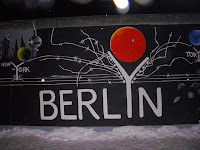
The euro (
€) is the official currency of the
European Union, and is used by 327 million Europeans in 16 of the 27 member countries. After the U.S. dollar, it is the 2nd largest reserve currency and the 2nd most traded currency.
Inspiration for the € symbol itself came from the Greek epsilon (Є), as a reference to the cradle of European civilization, and the first letter of the word Europe. It is crossed by two parallel lines to ‘certify’ the stability of the euro.

€1 is divided in to 100 cents. The coins come in denominations of 1c, 2c, 5c, 10c, 20c, 50c, €1 and €2. One side of the coin is common and the other side is a national side that shows an image specifically chosen by the country that issued the coin.
Kind of like how each U.S. quarter features a different state.
Banknotes come in denominations of €5, €10, €20, €50, €100,

€200 and €500. Each banknote has its own color and is dedicated to an artistic period of European architecture. The front of the note features windows or gateways and the back has bridges.
Just like
Czech money, the coins and banknotes get physically larger as the value increases.
Countries have to meet strict criteria in order to join the Eurozone. For example, a country's budget deficit must be less than 3% of it's GDP, its debt ratio must be less than 60% of its GDP, inflation must be low and interest rates must be close to the EU average. All new EU countries must work towards eventually adopting the euro. The only 3 long-standing EU countries that have yet to adopt it are the
UK,
Denmark and
Sweden. It will be several years before the Czechs start using it.
Slovakia switched to the euro 1 year ago.
I think Slovaks are kind of proud that they switched before the Czechs could.
It is nice to be able to use a single currency in most of Europe. The problem is that, for the most part, I now think in Czech Crowns. So when I see something priced in euros, I first have to mentally convert the euros into dollars, and then convert the dollars into crowns so that I realize just how much I'm spending.
Kind of crazy, I know. But at least I don't have to figure out marks, schillings and lire.
EDIT: The following countries all use the Euro as their official currency even though they are not members of the Eurozone or the EU:
Andorra,
Kosovo,
Monaco,
Montenegro,
San Marino and
Vatican City.
Update: In 2013, the
new €5 banknote was released in to circulation.
Update: In 2014, the
new €10 banknote was released in to circulation.
Update: In 2015, the
new €20 banknote was released in to circulation.
Update: In 2017, the
new €50 banknote was released in to circulation.
Update: In 2019, the
new €100 & €200 banknotes were released in to circulation.
 While in Berlin this past weekend, I made sure to get a Döner Kebap for lunch. It is a Turkish sandwich served in a wax paper sleeve. It is similar to a Greek gyro but döner are way better. Esp
While in Berlin this past weekend, I made sure to get a Döner Kebap for lunch. It is a Turkish sandwich served in a wax paper sleeve. It is similar to a Greek gyro but döner are way better. Esp ecially as a quick lunch or after a late night of drinking.
ecially as a quick lunch or after a late night of drinking. Döner is one of the most popular fast foods in Germany. Probably because of the country's large Turkish minority. In the 1960s, huge numbers of Turks came to Germany, as guest workers, to fill the acute labor shortages that existed at the time.
Döner is one of the most popular fast foods in Germany. Probably because of the country's large Turkish minority. In the 1960s, huge numbers of Turks came to Germany, as guest workers, to fill the acute labor shortages that existed at the time.









































































